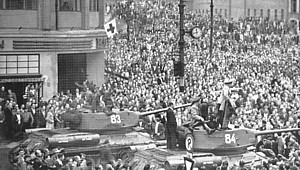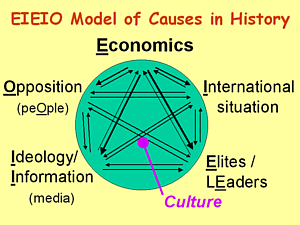June
17, 1953 Uprising (back to top)
 What
happened? Responding to pressure to work faster, construction workers
in East Berlin marched to government officials to demand a repeal of the
new norms. Disappointed with the response, they called for a general strike
across the country. Soviet forces were deployed to force strikers off
the streets. Timeline: What
happened? Responding to pressure to work faster, construction workers
in East Berlin marched to government officials to demand a repeal of the
new norms. Disappointed with the response, they called for a general strike
across the country. Soviet forces were deployed to force strikers off
the streets. Timeline:
- Apr. 1946: SPD and KPD "merge" into one
party, the SED
- Otto Grotewohl of the SPD, who had been in the USPD during WWI
and then returned to the reformist SPD, brings his party into the
union. He was arrested several times during the Nazi period but
remained in
 Germany. Germany.
- Walter Ulbricht of the KPD, who had emigrated to France and then
the Soviet Union in 1938, led his party. He was very loyal to Stalin.
- 1948: the SED is "Stalinized:" discussion
and dissent are not tolerated
- July 1952: 2nd SED party conference [according to
Klessmann 1988, 263]:
- "building of socialism" is decreed, forced collectivization
of factories and farms is the method
- as a consequence emigration from East Germany increases:
Jan. 1952: 7,200 refugees registered in the West (240/day);
Mar. 1953: 58,600 registered (1950/day)
Jan.-June 1953 estimate: 225,000-426,000 refugees [Fulbrook, Anatomy
1995, 180]
- March 5, 1953: Stalin dies
- jockeying for power in Moscow:
Beria ("New Course") might have ousted Ulbricht
Semyonov gains upper hand in early June, pursues "softer course"
- June 1953:
 East
German gov't raises work norms by 10% East
German gov't raises work norms by 10%
- Differing assessments are published in newspapers (Tribüne,
Neues Deutschland)
- For details, see Fulbrook 1992, 190f; or 2003 ed., 154f (on amazon,
search keyword Zaisser to read on-line)
- Malenkov summons Ulbricht and Grotewohl to Moscow, warns them
to correct the situation in East Germany by halting collectivization
and fostering independent businesses
- Announced by SU on June 9; rumors of Ulbrichts demise circulate,
expectation of repeal of work norm increase set to go into effect
- June 16, 1953: workers on the Stalinallee project
march to FDGB Union headquarters, then to the gov't House of Ministries,
demand repeal of norm increase. One "enterprising worker"
grabbed a megaphone and called for a general strike the next day. (role
of peOple/lEadership)
- June 17, 1953: 300,000-375,000 workers in most industrial
cities and towns strike or demonstrate, about 100,000 of them in East
Berlin (nationwide 5-7-10% of the total workforce, depending on whose
estimate you believe)
- Soviet tanks come out to clear the streets. About 125-250-500
people were killed and 1200 arrested
- Aug. 4, 1953: West German parliament passes a law
declaring June 17 a national holiday, The "Day of German Unity"
(although the strikes had nothing to do with a desire to unite with
West Germany).
Why did Ulbricht remain in power after 1953, when Khrushchev repudiated
the course that Stalin had set (and which Ulbricht wanted to continue
in East Germany)?
- at first Beria was ousted by Malenkow and Khruschev
- after the 1956 uprising in Hungary, SU wanted someone who could guarantee
continuity
What were the causes of the 1953 uprisings?
- Economic: work norms as trigger
- Interntional politics: regime change in the Soviet
Union--new course after Stalin
- Elites: Ulbricht set the goal for the accelerated
transition to socialism
- Ideology: workers believed it was their state and
government should listen to them
- peOple: voting with their feet: going on the streets
in droves to demonstrate, also leaving East Germany
For more information, see:
|

 That
is why the arrows of interaction leading out from it are darker: economics
moves other categories more directly, although all the other factors
together, combined with the luck or coincidence of natural resources
and environmental factors, determine economic developments. For so-called
primitive hunter-gatherer, nomadic and early agricultural societies,
one could substitute Environment as the heading, which
would include climate, topography and natural resources, as well as
diseases, animals and insects, etc..
That
is why the arrows of interaction leading out from it are darker: economics
moves other categories more directly, although all the other factors
together, combined with the luck or coincidence of natural resources
and environmental factors, determine economic developments. For so-called
primitive hunter-gatherer, nomadic and early agricultural societies,
one could substitute Environment as the heading, which
would include climate, topography and natural resources, as well as
diseases, animals and insects, etc.. What
happened? Responding to pressure to work faster, construction workers
in East Berlin marched to government officials to demand a repeal of the
new norms. Disappointed with the response, they called for a general strike
across the country. Soviet forces were deployed to force strikers off
the streets. Timeline:
What
happened? Responding to pressure to work faster, construction workers
in East Berlin marched to government officials to demand a repeal of the
new norms. Disappointed with the response, they called for a general strike
across the country. Soviet forces were deployed to force strikers off
the streets. Timeline: Germany.
Germany.
 East
German gov't raises work norms by 10%
East
German gov't raises work norms by 10%